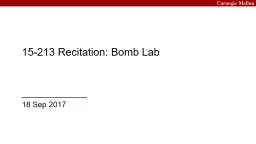PPT-15-213 Recitation: Bomb Lab
Author : conchita-marotz | Published Date : 2019-11-20
15213 Recitation Bomb Lab Your TAs September 16 th 2019 Agenda Logistics Bomb Lab Overview Introduction to GDB Appendix GDB and Assembly Tips Activity walkthrough
Presentation Embed Code
Download Presentation
Download Presentation The PPT/PDF document "15-213 Recitation: Bomb Lab" is the property of its rightful owner. Permission is granted to download and print the materials on this website for personal, non-commercial use only, and to display it on your personal computer provided you do not modify the materials and that you retain all copyright notices contained in the materials. By downloading content from our website, you accept the terms of this agreement.
15-213 Recitation: Bomb Lab: Transcript
Download Rules Of Document
"15-213 Recitation: Bomb Lab"The content belongs to its owner. You may download and print it for personal use, without modification, and keep all copyright notices. By downloading, you agree to these terms.
Related Documents














